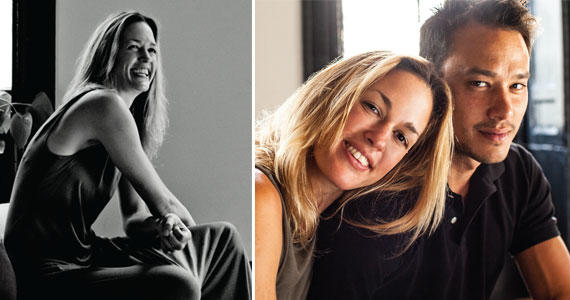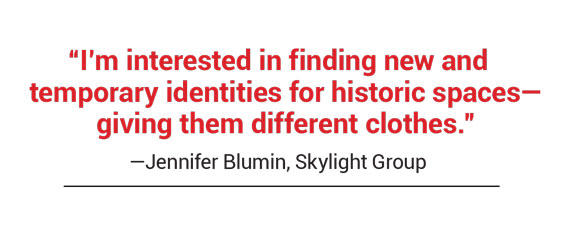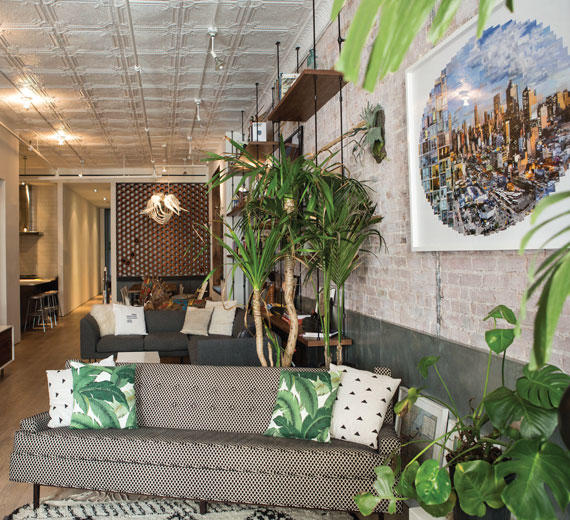Trending
Indiana Jen
A passion for abandoned spaces leads to New York Fashion Week’s holy grail

It’s like being an “urban Indiana Jones,” Jennifer Blumin recounts, barefoot and recumbent on the daybed in her Tribeca loft. “I go into these disgusting, forgotten, covered-in-dust spaces — places where no one has been in decades. But that’s where you find the coolest stuff.”
Curious and unafraid to get her hands dirty, Blumin, 38, founded Skylight Group, a company that adapts neglected historic buildings for one-off, high-end events. While she doesn’t own the buildings she operates in, she also doesn’t pay rent on the spaces, dividing the proceeds with landlords who benefit from the buzz she creates.
Days before this interview in late August, Blumin had just returned from an adventure trudging through the vaults of the old San Francisco mint, where she discovered an antique “gold-crushing machine” buried in pigeon droppings. Before that, she was pushing through pigeon nests to reach the rooftop of a forgotten, Rat Pack-era hotel in Las Vegas.
“I went into these old motel rooms in Vegas that were closed for decades, and there is gross stuff in there. But some of it is so awesome. You have to walk through cobwebs, they get in your mouth, but that is part of it,” she says. “It’s gross, but all of my spaces have started in that condition.”
But recently, Blumin’s taste for urban archeology has hoisted her into prominence: Two of Skylight’s venues — Skylight Clarkson Sq in Soho and Skylight at Moynihan Station in Chelsea — are the official homes of this year’s New York Fashion Week, as the event bids adieu to the tents at Lincoln Center.
Skylight at Moynihan Station is located in the historic James A. Farley Post Office on West 33rd Street across from Penn Station. At one time, the post office processed nearly 90 percent of the mail in all of the United States. Inside, Blumin recently reopened the former Grand Suite of New York’s Postmaster General, which was originally built for entertaining, and had been locked for decades.

Photography by STUDIO SCRIVO
Two miles south along the West Side Highway, the 60,000-square-foot Skylight Clarkson Sq once served as the final terminal on the old High Line. Today, it is a gleaming whitewashed chamber that seems designed from the outset for a catwalk.
Explaining her vision for Fashion Week, Blumin says: “Fashion Week had been in the tents, which are inherently ephemeral, they’re fleeting. But so many of these events are future-looking, so why do it in a temporary, pop-up-like box? You need to be tethered to something real.”
Blumin says she landed Fashion Week after the New York Times ran a profile on her in the Style section last September. Ari Emanuel, the powerhouse co-CEO behind talent agency William Morris Endeavor — IMG’s parent company — saw the article and called. “After that, my life went into many months of negotiations. I was swallowed from that point on, but in a good way,” Blumin says.
“It ate my life. I mean, I have a one year old, where is he?” she adds, gesturing around her lounge for her sons, Phineas, 3, and Theodore, 1.
But even before IMG signed the deal, Blumin’s rehabbed venues were the en vogue spots for parties, galas and runway shows for the likes of Nike, Google, Facebook, the Whitney Museum, Rag & Bone, and Proenza Schouler. Skylight’s Soho space has been the exclusive Fashion Week home to Ralph Lauren for the last 17 seasons.
Launching her business in 2004, she first transformed an 18,000-square-foot space at Hudson and Spring streets into a gallery-like, white-box venue. Over the next decade, she added Skylight One Hanson, better known as the former Williamsburg Savings Bank Clocktower in Brooklyn; and Skylight Modern on West 27th and 10th Avenue, a 15,000-square-foot blank canvas created for Fashion Week in 2013. A Skylight San Francisco will open soon.
“We’ve always had a very robust fashion business with the biggest names because we were the alternative venue. But now, all of the sudden, we are the main act,” Blumin says between sips of Evian water with powdered electrolytes (she met LLNYC in her home fresh from a yoga class).
“Fashion Week is about the designers and the clothes on the runway,” but this year, “it’s also about the culture of the designers,” which is Downtown Manhattan, she adds.

Although she clearly prefers her days spent parting spider webs in search of long-forgotten treasures, much of Blumin’s time is now consumed in “talks” with tight-fisted landlords and lawyers with noses for liabilities. It’s the unwelcome consequence of grown-up success.
She also sits on the board of the Lowline, an organization co-founded by her partner, architect James Ramsey. The group’s goal is to transform a massive, abandoned trolley station beneath Delancey Street on the Lower East Side into New York City’s first underground park.
But when she was starting out in NYC as a recent Cornell graduate, Blumin says she was blissfully ignorant of the risks associated with her emerging business.
Her first job came when one of her friends, a reporter at the New York Observer, mentioned to an Israeli billionaire during an interview that she knew the perfect person to transform his Downtown penthouse into an event space and photo studio. Her only experience at the time was occasional event planning for her entry-level corporate communications job.
“I’d say, “Sure, I can do this. Why can’t I do this? I got good grades. I’m 23. I can do anything,” she recalls. “I just thought that if I worked hard I could figure it out, and I did.”
Still, knowing what she does now, Blumin wonders if she could have ever gotten off the ground. “I was an English major in college. I’m from a super liberal academic family. I didn’t even understand what business was, which I actually think helped me. It’s unconscious incompetence,” she says.
“I could be confident when I started out because I had never taken an economics class, or been to business school. I didn’t know what I should be afraid of. Now I do, and things are more stressful accordingly. But I think it sort of helped me push out on my own early.”
That approach meant that Blumin had to learn from mistakes, often after it was too late. She remembers one early disaster that left her in trouble with the police, after she was approached by a client and handed cash for a birthday event.
The representative for the “private individual” told her that the birthday party would have “about 90 people.” “I was like, ‘Okay! Sounds like a great idea but you should get security,’” Blumin says. “It turned out that individual was Mike Tyson and it wasn’t 90 people, it was 900 people.”
When she asked security to close the doors and turn people away, they kicked her out.
“I called the police from outside on Broadway and 4th and was like, ‘You need to help me. This is out of control!’ Instead they gave me four summonses. I said, ‘Wait, I called you for help, not to get in trouble.’ But that is not how it works.”
From then on Skylight would hire its own security — at the renter’s expense, naturally.
A similar learn-as-you go approach is on display in her 2,000-square-foot Tribeca loft, which was designed by Ramsey.
“My overall approach to the whole thing was to salvage as much of the historical stuff as possible,” Ramsey says, pointing out the original tin ceilings and windows in the loft.

Photography by STUDIO SCRIVO
Together, Ramsey and Blumin gut renovated the 1830s commercial space, which was originally a munitions store, and in poor condition when they found it. Today, a replica of a Beluga whale skeleton hangs above the dining room table.
“I wanted a place that was full of warm natural materials, but also somewhere I could put all the clutter and awesome little objects I’ve collected over the years,” Ramsey says.
Fittingly, the couple’s collections are every bit as unconventional as Skylight’s venues. They include Mesoamerican ceramic artifacts “that are like a thousand years old” from Teotihuacan outside Mexico City; arrowheads from Ramsey’s family’s farm in Central Tennessee; trilobite fossils; vintage guitars; a calf-sized 16th-century, carved wooden horse from South India; and scrimshaw.
“Scrimshaw is almost like outsider art. Basically, a bunch of bored sailors back in the whaling days would cover sperm whale teeth with these weird etchings. Most of them were semi-pornographic, although I have not yet found any of those,” Ramsey beams.
Like Blumin’s event spaces, her home is curated, carefully planned and a bit eccentric. And perhaps, like her event spaces, it’s not really about the white-oak floors or the frequent dinner parties that have exhausted her 300-bottle wine rack (made from old terracotta drain pipes).
Maybe, taken as a microcosm, it’s about the dialectic between new and old Tribeca that has produced something entirely new.
“I’m not interested in events for events’ sake,” Blumin says. “I’m interested in reconceiving spaces, and finding new and temporary identities for historic spaces — giving them different clothes. I don’t want to overly fetishize history and keep it in amber, but to adaptively reuse it. I think the interplay of those things is interesting, and that’s why I think we’ve driven the company bigger and bigger and toward more landmark and historic spaces.”




